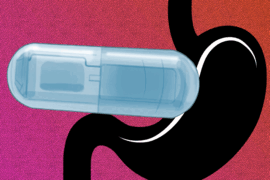Gastric balloons — silicone balloons filled with air or saline and placed in the stomach — can help people lose weight by making them feel too full to overeat. However, this effect eventually can wear off as the stomach becomes used to the sensation of fullness.
To overcome that limitation, MIT engineers have designed a new type of gastric balloon that can be inflated and deflated as needed. In an animal study, they showed that inflating the balloon before a meal caused the animals to reduce their food intake by 60 percent.
This type of intervention could offer an alternative for people who don’t want to undergo more invasive treatments such as gastric bypass surgery, or people who don’t respond well to weight-loss drugs, the researchers say.
“The basic concept is we can have this balloon that is dynamic, so it would be inflated right before a meal and then you wouldn’t feel hungry. Then it would be deflated in between meals,” says Giovanni Traverso, an associate professor of mechanical engineering at MIT, a gastroenterologist at Brigham and Women’s Hospital, and the senior author of the study.
Neil Zixun Jia, who received a PhD from MIT in 2023, is the lead author of the paper, which appears today in the journal Device.
An inflatable balloon
Gastric balloons filled with saline are currently approved for use in the United States. These balloons stimulate a sense of fullness in the stomach, and studies have shown that they work well, but the benefits are often temporary.
“Gastric balloons do work initially. Historically, what has been seen is that the balloon is associated with weight loss. But then in general, the weight gain resumes the same trajectory,” Traverso says. “What we reasoned was perhaps if we had a system that simulates that fullness in a transient way, meaning right before a meal, that could be a way of inducing weight loss.”
To achieve a longer-lasting effect in patients, the researchers set out to design a device that could expand and contract on demand. They created two prototypes: One is a traditional balloon that inflates and deflates, and the other is a mechanical device with four arms that expand outward, pushing out an elastic polymer shell that presses on the stomach wall.
In animal tests, the researchers found that the mechanical-arm device could effectively expand to fill the stomach, but they ended up deciding to pursue the balloon option instead.
“Our sense was that the balloon probably distributed the force better, and down the line, if you have balloon that is applying the pressure, that is probably a safer approach in the long run,” Traverso says.
The researchers’ new balloon is similar to a traditional gastric balloon, but it is inserted into the stomach through an incision in the abdominal wall. The balloon is connected to an external controller that can be attached to the skin and contains a pump that inflates and deflates the balloon when needed. Inserting this device would be similar to the procedure used to place a feeding tube into a patient’s stomach, which is commonly done for people who are unable to eat or drink.
“If people, for example, are unable to swallow, they receive food through a tube like this. We know that we can keep tubes in for years, so there is already precedent for other systems that can stay in the body for a very long time. That gives us some confidence in the longer-term compatibility of this system,” Traverso says.
Reduced food intake
In tests in animals, the researchers found that inflating the balloon before meals led to a 60 percent reduction in the amount of food consumed. These studies were done over the course of a month, but the researchers now plan to do longer-term studies to see if this reduction leads to weight loss.
“The deployment for traditional gastric balloons is usually six months, if not more, and only then you will see good amount of weight loss. We will have to evaluate our device in a similar or longer time span to prove it really works better,” Jia says.
If developed for use in humans, the new gastric balloon could offer an alternative to existing obesity treatments. Other treatments for obesity include gastric bypass surgery, “stomach stapling” (a surgical procedure in which the stomach capacity is reduced), and drugs including GLP-1 receptor agonists such as semaglutide.
The gastric balloon could be an option for patients who are not good candidates for surgery or don’t respond well to weight-loss drugs, Traverso says.
“For certain patients who are higher-risk, who cannot undergo surgery, or did not tolerate the medication or had some other contraindication, there are limited options,” he says. “Traditional gastric balloons are still being used, but they come with a caveat that eventually the weight loss can plateau, so this is a way of trying to address that fundamental limitation.”
The research was funded by MIT’s Department of Mechanical Engineering, the Karl van Tassel Career Development Professorship, the Whitaker Health Sciences Fund Fellowship, the T.S. Lin Fellowship, the MIT Undergraduate Research Opportunities Program, and the Boston University Yawkey Funded Internship Program.











